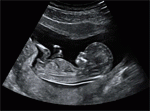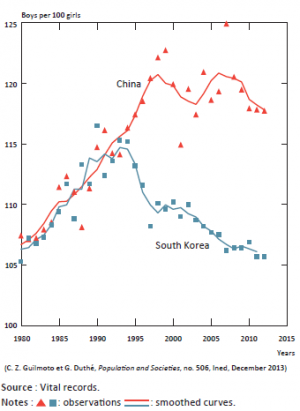Selective abortion in Asia
On average, 105 boys are born for every 100 girls. However, in China, India and several other Asian and Caucasian countries, the proportion of newborn boys is abnormally high because couples practice sex-selective abortion.
In 2010 for example, there were up to 118 male births per 100 female in China, 117 in Azerbaijan and almost 115 in Armenia. Abortion is used as a means to avoid having a girl child, but it does not increase the chances of having a boy in a subsequent pregnancy.
In Asia, a combination of factors

The increase in male births in Asia results from the combination of four factors:
- a continuing preference for boys: sons perpetuate the family line and look after their parents in old age, while girls are generally expected to join their husband’s family ;
- the spread of ultrasound screening since the 1980s, making it possible to determine the sex of a fetus before birth;
- access to abortion (legal or illegal);
- fertility decline: when families had 5 or 6 children (around 1960), the chances of not having a boy were very low (2%). But with only 2 children, the risk is much higher (25%).
In some countries, the sex of the first child is left to chance

In China, the one-child policy has certainly also played a role. But it does not explain everything, since the same sex imbalance is observed in Vietnam and in South Korea. The surplus of boys is often not observed until the second birth and becomes more marked as parity increases. In South Korea, in 2000, more than two-thirds of third births were boys.
Conversely, when the first is child is a boy, an excess of girls is observed for the second birth. Couples are happy to have a girl if the first child was a son, and will abort a male fetus if necessary.
Imbalance on the marriage market
For many men it is now difficult to find a wife. Their only solution may be to marry a widow or a divorcee, or to look for a wife abroad. Female migration for marriage purposes is increasing rapidly. Other consequences of this imbalance may be an increased age gap between husband and wife, and a drop in births due to the smaller number of women. Population growth in these countries may slow down faster than expected, and population ageing may be more acute.
Sources:
- C. Z. Guilmoto, Géraldine Duthé (2013), "Masculinization of births in Eastern Europe", Population & Societies, n°506
- Gilles Pison (2004), "Fewer births, but a boy at all costs: selective female abortion in Asia", Population & Societies, n°404
Contact: Isabelle Attané, Géraldine Duthé, Christope Z Guilmoto, Gilles Pison
Online : 03 November 2014
